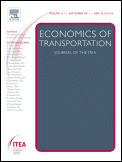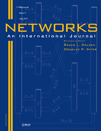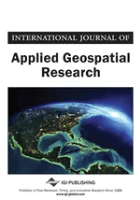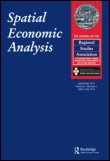
NETWORKS & SPATIAL ECONOMICS
Scope & Guideline
Innovating Insights in Spatial Economics and Network Theory
Introduction
Aims and Scopes
- Spatial Optimization and Network Design:
Research in this area includes optimization models for facility location, transportation networks, and urban planning that consider spatial constraints and economic efficiency. - Dynamic and Stochastic Modeling:
This encompasses studies that utilize stochastic programming and dynamic models to address uncertainties in demand, supply, and travel behaviors, reflecting real-world complexities. - Game Theory and Strategic Interactions:
The journal features papers that apply game-theoretic approaches to analyze competitive behaviors in networked environments, such as transportation and logistics. - Agent-Based and Simulation Models:
Research that employs agent-based modeling to capture individual behaviors and interactions within spatial economic frameworks is a key focus, providing insights into emergent phenomena. - Resilience and Vulnerability Analysis:
Papers addressing the resilience of networks and systems to shocks, as well as their vulnerability, particularly in the context of crises and natural disasters, are prominently featured. - Multi-Modal Transport Systems:
Studies exploring the integration and optimization of various transport modes, including public transit and private vehicle interactions, are essential to the journal's scope.
Trending and Emerging
- Sustainability and Green Logistics:
Increasing attention is being paid to sustainable transport solutions and green logistics, particularly in the context of electric vehicles and eco-friendly facility design. - Impact of Technology on Mobility:
Research focusing on the implications of new technologies, such as autonomous vehicles and smart transportation systems, is gaining traction, emphasizing their transformative effects on spatial economics. - COVID-19 and its Economic Impacts:
The ongoing analysis of the pandemic's influence on travel behavior, transport networks, and urban mobility patterns has become a significant area of interest, providing insights into resilience strategies. - Data-Driven Decision Making:
There is a rising trend in utilizing big data and advanced analytics in network modeling, allowing for more informed decision-making in urban planning and transportation. - Collaborative Consumption and Shared Mobility:
Emerging themes around shared mobility solutions and collaborative consumption models are increasingly being explored, reflecting changing consumer behaviors and preferences in urban settings.
Declining or Waning
- Traditional Economic Models without Spatial Considerations:
The journal has seen a decrease in papers that utilize classical economic models that do not incorporate spatial dimensions, as researchers increasingly recognize the importance of spatial interactions. - Static Facility Location Models:
There has been a waning interest in purely static models for facility location, with a shift towards more dynamic and responsive approaches that consider changing conditions and uncertainties. - Purely Theoretical Research:
Research that is primarily theoretical without empirical applications or simulations has seen reduced publication frequency, as the journal emphasizes practical implications and real-world applications. - Generalized Network Analysis:
While still relevant, the broad category of generalized network analysis has become less prominent as the focus narrows to specific applications in transportation and urban systems. - Single-Dimensional Transportation Studies:
There is a noticeable decline in studies that examine transportation issues from a singular perspective, as multidimensional approaches that integrate various factors are becoming more favored.
Similar Journals

Applied Network Science
Innovating methodologies for tomorrow's network challenges.Applied Network Science is a premier open access journal published by SpringerNature that has been a vital resource in the fields of computational mathematics and computer networks since its inception in 2016. With an impressive Q1 ranking in Multidisciplinary fields and Q2 rankings in both Computational Mathematics and Computer Networks and Communications, it distinguishes itself as a significant contributor to interdisciplinary research efforts. The journal fosters innovative methodologies and applications within network science, making it a crucial platform for researchers, professionals, and students alike. With an E-ISSN of 2364-8228 and a commendable standing in global rankings, it supports a broad audience through its commitment to open access, ensuring that groundbreaking research is readily available. Located in Switzerland, Applied Network Science continues to shape the landscape of network research and communication, making substantial impacts across various domains.

Revue d Economie Regionale et Urbaine
Fostering dialogue in the heart of economic geography.Revue d Economie Regionale et Urbaine is a prestigious journal published by ARMAND COLIN, dedicated to advancing the field of regional and urban economics. Renowned for its rigorous peer-reviewed articles, this journal provides a vital platform for scholars, practitioners, and students to explore contemporary issues, methodologies, and case studies in regional development, urban policy, and economic geography. With its ISSN 0180-7307 and E-ISSN 2107-0865, the journal facilitates widespread dissemination of knowledge, although it currently does not offer open access options. Situated in Paris, France, Revue d Economie Regionale et Urbaine plays a critical role in fostering dialogue and innovation among academics and policymakers alike, contributing significantly to the understanding and enhancement of urban and regional economies.

Economics of Transportation
Elevating the discourse on transport infrastructure and sustainability.Economics of Transportation is a premier academic journal published by ELSEVIER, dedicated to advancing the field of transportation economics. Since its inception in 2012, this journal has carved a niche for itself, ranking in the Q1 category for both Economics, Econometrics and Finance, as well as Transportation in the 2023 rankings. With an impressive Scopus Rank of 34 out of 242 in its primary category, and a percentile of 86, it serves as a crucial platform for disseminating high-quality research that influences policy and practice in transportation systems worldwide. Though it operates on a subscription basis, the journal's commitment to integrating theoretical insights with practical applications makes it an indispensable resource for researchers, professionals, and students dedicated to understanding and improving transportation economics. Its comprehensive scope includes topics ranging from market analysis and transport infrastructure economics to sustainability and technology, thus ensuring its relevance to contemporary issues faced in the field.

Journal of Spatial and Organizational Dynamics
Unlocking the Potential of Spatial and Organizational StudiesJournal of Spatial and Organizational Dynamics is a distinguished peer-reviewed journal published by the CIEO, RESEARCH CENTER SPATIAL & ORGANIZATIONAL DYNAMICS, based in Faro, Portugal. Since its inception in 2013, this open access journal has aimed to advance the fields of spatial and organizational studies by providing a platform for innovative research that addresses the dynamic interactions between spatial environments and organizational practices. With a diverse scope that encompasses topics such as urban planning, organizational behavior, and geospatial analysis, the journal fosters interdisciplinary dialogue and insights critical for professionals and academics alike. The journal's commitment to accessibility ensures that research findings are readily available to a global audience, empowering researchers, students, and practitioners to explore the intricacies of spatial dynamics within organizational contexts. By contributing to the growing body of literature in this vital area, the Journal of Spatial and Organizational Dynamics stands as an essential resource for those dedicated to understanding and shaping the interplay between spaces and organizations.

Computational Economics
Advancing the Intersection of Economics and Computation.Computational Economics is a premier journal dedicated to advancing the interdisciplinary field that bridges computational methods and economic theory. Published by Springer in the Netherlands, this journal serves as a critical platform for researchers and practitioners from economics, econometrics, and computer science, fostering innovation and cross-pollination of ideas from 1993 to 2024. With a notable impact factor in its categories—ranking Q2 in Economics, Econometrics, and Finance and Q3 in Computer Science Applications—Computational Economics consistently delivers rigorous peer-reviewed research that addresses contemporary challenges in economic modeling and computational techniques, making it an indispensable resource for the academic community. The journal provides a range of access options and is indexed in Scopus, where it holds a strong position in the 78th percentile of its category, ensuring high visibility and engagement for published works. Researchers, students, and professionals will find valuable insights across its diverse scope, facilitating the exploration of new methodologies that shape the future of economic analysis.

NETWORKS
Advancing the Frontiers of Network ResearchNETWORKS, an esteemed journal published by Wiley, serves as a premier platform for the dissemination of high-quality research in the fields of computer networks, communications, hardware architecture, and information systems. With an ISSN of 0028-3045 and an E-ISSN of 1097-0037, the journal has been at the forefront of networking studies since its inception in 1971 and continues to thrive, boasting a convergence period that extends into 2024. Recognized for its rigorous peer-review process, NETWORKS is placed in the Q1 and Q2 quartiles of various categories, underscoring its significant impact and relevance in the realm of computer science. Although there is no open access option currently available, the journal remains a vital resource for researchers, professionals, and students who seek to navigate the evolving landscapes of technology and innovation. With its robust Scopus rankings and a growing readership, NETWORKS is dedicated to fostering advancements in network theory and practice, making it an essential read for those at the cutting edge of this dynamic field.

International Journal of Applied Geospatial Research
Empowering multidisciplinary contributions in geospatial research.International Journal of Applied Geospatial Research is an esteemed publication dedicated to advancing the field of geospatial research. Published by IGI Global, this journal provides a platform for innovative studies from 2010 to 2024 that encourage multidisciplinary contributions across Earth and planetary sciences and geography. While currently not offering open access, the journal's focus on applied research ensures that it remains highly relevant to both academics and industry professionals alike. With an ISSN of 1947-9654 and an E-ISSN of 1947-9662, it has been indexed in various databases, reflecting its emerging significance with rankings such as Q4 in Earth and Planetary Sciences and Geography according to Scopus, placing it at the intersection of critical research and practical application. Researchers, professionals, and students can expect insightful articles that enhance understanding and drive innovation in geospatial applications essential for informed decision-making in a rapidly changing world.

JOURNAL OF REAL ESTATE FINANCE AND ECONOMICS
Unveiling insights into the economics of urban development.JOURNAL OF REAL ESTATE FINANCE AND ECONOMICS, published by Springer, stands as a vital resource in the field of real estate economics, bringing together innovative research, theoretical frameworks, and empirical studies since its inception in 1988. With an evolving focus that spans various aspects of real estate finance and urban economic dynamics, this journal occupies a prominent position in the academic landscape, reflected in its Q2 ranking in Accounting, Economics and Econometrics, and Finance, alongside a prestigious Q1 status in Urban Studies. Boasting a significant international readership, this journal serves as a key platform for researchers and industry professionals to share groundbreaking findings, thus facilitating knowledge exchange in a rapidly changing economic environment. While the journal currently operates under a subscription model, it remains committed to advancing scholarship with a high impact factor that underscores its relevance and contributions to the ongoing discourse in real estate finance and economics.

Spatial Economic Analysis
Unraveling Economic Trends Through Spatial LensesSpatial Economic Analysis, published by Routledge Journals, Taylor & Francis Ltd, stands at the forefront of interdisciplinary research bridging economics, geography, and environmental science. With a notable impact factor reflected in its prestigious Q1 quartile rankings across key categories such as Earth and Planetary Sciences, Economics, Econometrics and Finance, and Geography, this journal is pivotal for scholars seeking to understand the intricate dynamics of spatial phenomena and their economic implications. Its comprehensive scope and rigorous peer-review process ensure that only high-quality research is disseminated, fostering innovative solutions to pressing global challenges. As of 2024, and since its inception in 2006, Spatial Economic Analysis continues to thrive as a vital platform for researchers, professionals, and students alike, facilitating access to cutting-edge studies that shape the future of spatial economics and policy.

B E Journal of Theoretical Economics
Cultivating a deeper understanding of economic frameworks.The B E Journal of Theoretical Economics, published by WALTER DE GRUYTER GMBH, is a prominent academic journal based in Germany, dedicated to advancing research in the field of theoretical economics. With an ISSN of 2194-6124 and an E-ISSN of 1935-1704, this journal has been a valuable resource for scholars since its inception. Recognized for its contributions to the economics domain, it holds a Q3 ranking in the Economics, Econometrics and Finance category as of 2023, positioning it among noteworthy publications within the discipline. Although the journal operates under a traditional publishing model rather than open access, it remains committed to disseminating high-quality theoretical research and fostering scholarly discussions that bridge various economic theories and applications. Researchers, professionals, and students looking to deepen their understanding of economic theory will find a wealth of insights and innovative perspectives within the journal's pages, which have been published with a focus on evolving theoretical frameworks from 2001 to 2003 and again since 2007 through 2024.